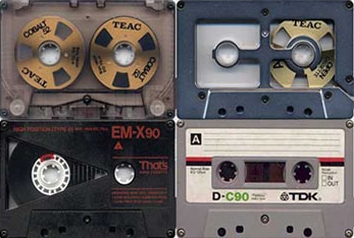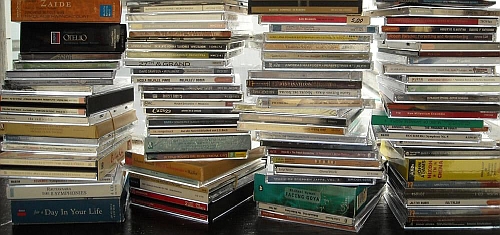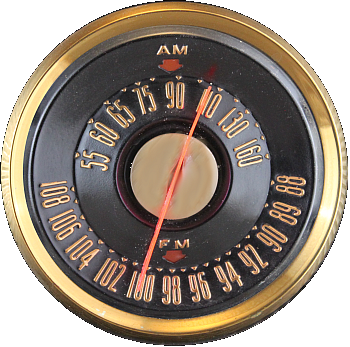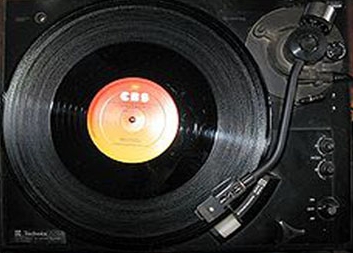We’ve been recording music for somewhat less than 150 years now, using many different techniques and formats which have their strengths and weaknesses but until recently, they all required some sort of physical medium to store the recorded information and some kind of device to play it back. The device was often bulky, unwieldy, expensive and incompatible with other recording formats; you can’t play a cassette on an 8-track machine.
Today we can listen to almost any recording ever made virtually any time we want, using simple, cheap and portable devices and wthout the need for a physical music library yet many music fans cling to the old ways. Much has been made of the resurgence of vinyl records which, even though it is actually a very small part of the market, is still growing dynamically while other kinds of physical media – CDs in particular, are very quickly fading away.
For some it is just the look, feel and attractiveness of a particular medium; I still love my old 78s, young vinyl enthusiasts tend to favour the LP, while others love cassettes or whatever they grew up with. Many insist that the sound of analogue recording is much superior to any digital sound though that is highly debatable and hard, if not impossible to prove.
It is truly amazing just how many ways we have recorded, and replayed music. Although Thomas Edison is credited with inventing the phonograph in 1877 in fact it was a Frenchman named Édouard-Léon Scott de Martinville who patented the first recording device some twenty years earlier. The Phonautograph used a diaphragm to capture the sound and a quill to transcribe it on a rotating cylinder of glass blackened by smoke. Because the waveform was not etched, there was no way to play it back. Scott’s invention was intended to aid in the study of sound waves in the laboratory however computer technology has recently allowed researchers to actually hear some of the sounds he recorded. As of 2008, the earliest recorded sound we have (which you can listen to on the Internet) is not Edison reciting Mary Had A Little Lamb but Scott singing Au Clair de la Lune in 1860. It’s only 21 seconds long and nobody will claim it has superior fidelity but it is a recorded song.
The first commercial music recordings were made acoustically and played back the same way, no electronics involved. While to many, the sound reproduced on those ancient machines is much like having spikes hammered into your ears there are those who love it and declare that it is the only “pure” recording method.
The first digital format was invented in 1883.
Piano rolls were invented in Germany for automatic playing machines called Orchestriorns and later adapted for pianos. Most were recorded by having someone play on a recording piano that punched holes in the paper roll to match the notes being played, so it was mechanical, but digital. The same technology was later used in early “punch-card” computers. After the initial recording, technicians would encode tracks to control the pedals and give the music loud and soft dynamics. With a good player piano, you could hear the tune pretty well exactly as it was originally played. With a bit of fiddling about, companies could, and did, make recordings that were impossible for any human being to play. Piano rolls are still being made today, though not mass produced.
 Magnetic recording has also been around a lot longer that you might think. The Telegraphone was patented in the U.S. by Valdemar Poulsen in 1900. Designed to record telephone conversations and dictation it worked much the same way as a modern tape recorder but used wire as the recording medium. Wire recorders for music and in-home use were very popular for about ten years starting in the late 1940s when tape recorders were still too bulky and expensive. Eventually magnetic tape took over but steel wire is more compact and heat-resistant than plastic tape so it was used in very small machines designed for espionage, airplane flight recorders and even in satellites right up to the 1970s.
Magnetic recording has also been around a lot longer that you might think. The Telegraphone was patented in the U.S. by Valdemar Poulsen in 1900. Designed to record telephone conversations and dictation it worked much the same way as a modern tape recorder but used wire as the recording medium. Wire recorders for music and in-home use were very popular for about ten years starting in the late 1940s when tape recorders were still too bulky and expensive. Eventually magnetic tape took over but steel wire is more compact and heat-resistant than plastic tape so it was used in very small machines designed for espionage, airplane flight recorders and even in satellites right up to the 1970s.
In 1919 American inventor Lee De Forest invented optical sound recording for the film industry which eventually produced far superior recordings but because there was no consumer level playback equipment, the technology was not suitable for the music industry.
The invention of magnetic tape and the vinyl LP format ushered in the modern era of high fidelity sound. It was aided in no small way by better microphone technology and by fabulous, high-ceilinged recording studios so there is good reason to believe recordings from the 50s are a high point in recorded sound. The Compact Disc, which was introduced in 1982, ended the vinyl era but now young vinyl enthusiasts and collectors are driving the resurgence of this old medium.
This is where it gets interesting. The vinyl camp insists that, because vinyl records contain analogue sound, they are inherently better than any digital method which samples the analogue signal and re-assembles it on playback. They believe CDs sacrifice good sound for convenience.
An article by Chris Kornelis published in LA Weekly in January, 2015 effectively puts the kybosh on all that (www.laweekly.com/music/why-cds-may-actually-sound-better-than-vinyl-5352162). While vinyl enthusiasts believe analogue sound trumps digital, recording engineers, the people who actually make the records, vehemently disagree.
The story goes that analogue methods record the pure, unadulterated sound waves so it is warmer, more real sounding. Sorry, not so. In order to make the etched sound waves fit into a very tiny space, they are adulterated a lot. The extreme low end has to go because to include it would make the needle jump out of the groove. The extreme high end also causes problems so it’s cut back. The sound is then compressed; the loud parts are reduced to help prevent skipping and the quiet parts are increased to get past the natural noise that all records have. Then there’s pre-emphasis and de-emphasis and all kinds of tinkering about that makes the signal anything but pure. The “warm” sound is actually distortion.
The top record producers of the day agree, after months of working in the studio to get a perfect sound, they were always disappointed with the final release on vinyl. While some still will use old school magnetic tape for recording and release their product on vinyl, they do it because that’s what the artist wants, not because it is better.
 The Compact Disc was invented by James Russell, a brilliant serial inventor and a passionate classical music fan. He tried to get the best sound from his LPs; he made his own turntable, and used wooden needles that he sanded by hand but he could not get an LP recording to sound anywhere near as good as a concert performance. He studied the problem for years and eventually combined optics, digital technology and other disciplines to create what he considered the perfect recording system, one that could handle the lowest lows, the highest highs, the loudest and the quietest sounds and had no background noise. His sole intention was to make better sounding recordings; the fact that the CD was more convenient was a side-effect.
The Compact Disc was invented by James Russell, a brilliant serial inventor and a passionate classical music fan. He tried to get the best sound from his LPs; he made his own turntable, and used wooden needles that he sanded by hand but he could not get an LP recording to sound anywhere near as good as a concert performance. He studied the problem for years and eventually combined optics, digital technology and other disciplines to create what he considered the perfect recording system, one that could handle the lowest lows, the highest highs, the loudest and the quietest sounds and had no background noise. His sole intention was to make better sounding recordings; the fact that the CD was more convenient was a side-effect.
The CD initially got a bad rap because the early analogue to digital converters used in studios delivered a harsh sound; they improved about five years later. The record companies made it worse by over charging us for something that was actually cheaper to manufacture. They re-released most of their back catalogues, usually with much better sound and sometimes with extensive documentation, but at a higher price. A CD can sound worse than a vinyl record but only if it is not made right, it is not inherent in the process. And get this; our ears are digital, not analogue. Tiny receptors in our ears break down sound in to tiny chunks - digitizes it - and sends it to the brain which then turns it back into a continiuous sound.
Vinyl enthusiasts love the experience of playing, or just owning a real record which is fine but to me, if you want to build a physical music collection based on something more than downloads and playlists forget vinyl and go for CDs. They can be found at bargain prices and there’s a lot of great music available on what may eventually be recognized as the best recording medium ever.

